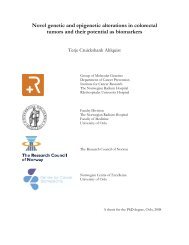Preface - Ous-research.no
Preface - Ous-research.no
Preface - Ous-research.no
You also want an ePaper? Increase the reach of your titles
YUMPU automatically turns print PDFs into web optimized ePapers that Google loves.
Experimental microsurgery and Transplantation<br />
Leader:<br />
Pål-Dag Line, MD, PhD, Chairman, Division of Specialiced<br />
Medicine and Surgery, OUH.<br />
Scientific staff:<br />
Aksel Foss, Professor, MD, PhD, MHA,<br />
Section for Transplantation Surgery (OUH/UiO)<br />
Helge Scott, Professor, MD, PhD, Dept. of Pathology (OUH/UiO)<br />
Bjarte Fosby,MD, Section for Transplantation Surgery,<br />
PhD Student (OUH)<br />
Jihua Shi, MD, Section for Transplantation Surgery, PhD<br />
Student (OUH)<br />
Henrik Huitfeldt, Professor, MD PhD Department of Pathology<br />
(OUH/UiO)<br />
Vivi Bull Stubberud, RN, OR Department (OUH)<br />
Introduction<br />
The <strong>research</strong> group is a collaborative project between the<br />
Section for Transplant surgery at the Division of specialiced<br />
Medicine and Surgery and the Institute of pathology. A<br />
subset of various experimental transplantation models and<br />
other surgical models have been established in order to<br />
form a solid platform that allow us to explore our main fields<br />
of interest within experimental transplantation, transplantation<br />
immu<strong>no</strong>logy and hepatic regeneration and cancer.<br />
Surgical models<br />
In the cuff-based cervical heterotopic transplantation<br />
technique we transplant the do<strong>no</strong>r heart to the neck of the<br />
recipient. Anastomoses between the graft aorta and the<br />
carotid artery, and between the pulmonary artery and the<br />
external jugular vein are cuffed as reported by Heron. A<br />
transplanted heart is shown in figure 1.<br />
Head of Department Pål-Dag Line<br />
We have also established orthotopic liver transplantation<br />
models in the rat. This is a <strong>no</strong>n arterialized, model, where<br />
the portal vein and the infrahepatic cava is anastomosed<br />
by cuff technique whereas the proximal, suprahepatic cava<br />
is sutured. The model is performed partly as a whole graft<br />
transplant, but when indicated partial liver transplantation<br />
of various size is achieved by performing lobar resections<br />
on the graft.. The model can also be combined with portocaval<br />
shunting, utilizing a carotid artery graft as a shunt.<br />
Figure 2 (left) shows a<br />
transplanted rat Liver<br />
Firure 3 shows a portocaval<br />
shunt where a carotid artery graft<br />
is sutured end-to-side to the vena<br />
porta and cava respectively.<br />
Compared to conventional techniques of anastomosis the<br />
cuff method reduces graft cold ischemia and bleeding from<br />
the anastomoses. A<strong>no</strong>ther advantage with the method is<br />
the superficial localization of the graft in the recipient’s neck<br />
which simplifies registration<br />
of graft function and<br />
enables exact judgement of<br />
endpoint for the rejection<br />
process. Graft ischemia is<br />
typically 5-10 min, and the<br />
technical success rate above<br />
90%.<br />
Figure 1. Heart transplanted to<br />
the neck of the recipient animal.<br />
39
















